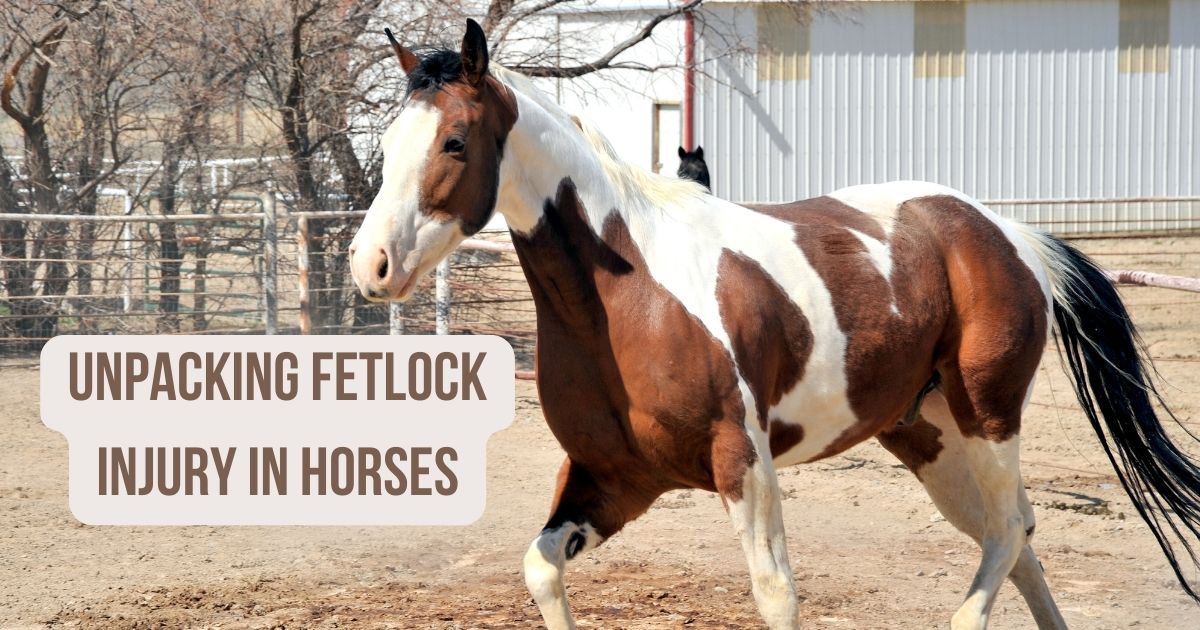An equine athlete, or a horse, is generally prone to musculoskeletal injuries, such as a fetlock injury. The fetlock joint is a crucial nexus of bone, tendon, and ligament that plays a pivotal role in a horse’s ability to move gracefully and powerfully.
Let us answer the question “What is a fetlock injury” and navigate the complexities of fetlock injuries, shedding light on their causes, types of injuries, and, most importantly, effective management strategies.

What is a Fetlock Injury?
A horse fetlock injury is damage or trauma affecting the complex joint between the cannon bone and the pastern (equivalent to the leg and foot bones). The fetlock joint is pivotal in the horse’s locomotion, weight-bearing, and overall well-being.
Since the fetlock joint is complex, so is its injury. Different types of injuries are classified as fetlock injuries and may vary in the compromised area, bone, tendon, synovial membrane, etc. There are also inoperable fetlock injuries and operable fetlock injuries.
When an equine runs at top speed during a race, the bones in the fetlock on a horse are under enormous stress and strain. It is common for horses to have injuries and pain in that area. These injuries are more aggravated in the front limbs. However, the hind limb can also have similar and considerable damage.
Therefore, horse owners must understand the nature of fetlock injury in horses to promote early detection and effective management.
Where is a Horse’s Fetlock Located?
The horse fetlock is in the lower part of a horse’s leg and is a critical connection between the long pastern bones and the cannon bone. This is referred to as the horse ankle in layperson’s terms.
Its strategic location enables the horse to bear weight and engage in various physical activities such as running, jumping, and standing.
This crucial joint is anatomically similar to the human ankle and provides a similar role to the horse, just as in humans.
Proximal Sesamoid and Phalanges Fractures
Proximal sesamoid and phalanges fractures are noteworthy among the array of fetlock injuries. These fractures involve the small sesamoid bones and the phalanges near the fetlock joint. They result from intense physical exertion, accidents, or repetitive stress, necessitating prompt veterinary attention.
This type of injury is common in Quarter horses, Thoroughbreds, and Standardbreds and occurs together with injury to the suspensory ligament. Signs of fracture include pain, swelling, lameness, bleeding, and heat around the fetlock. Signs are severe when the fetlock joint is bent, resembling a broken fetlock.
It is advisable to have an x-ray taken during diagnosis, and treatment is crucial to prevent long-term complications and ensure the horse’s well-being. There is a guarded prognosis, especially when it occurs at the base of the joint.

Osselets
Osselet means a little bone. However, osselets in horse health refer to inflammatory conditions affecting the surrounding areas of the fetlock joint. This creates swelling and pain around the joint, impacting movement and performance.
It is often observed in athletic horses and is often affiliated with repetitive stress or trauma, impacting the soft tissues and causing discomfort for the horse. Osselets usually occur in the forelimbs due to pronounced strain and concussion on the fetlock rather than in the hind legs.
Early detection, attention, and treatment are crucial in managing osselets.
Fetlock Injury Recovery Time
Fetlock injury recovery time varies depending on the injury’s specific nature and severity. While some cases may heal with rest and rehabilitation, others might require more intensive treatment, including veterinary interventions and a structured recovery plan tailored to the individual horse.
A structured recovery plan facilitates the healing process, including rest, physical therapy, and controlled exercise. Owners must be patient and adhere to veterinary instructions, which might take a while before the horse returns to full health.
Ringbone Inflammation
Ringbone, characterized by connective tissue inflammation around the fetlock joint, can impede a horse’s mobility and lead to chronic discomfort and sometimes lameness. It occurs around the pastern or coffin joint. This condition, classified as high or low ringbone, affects different fetlock areas.
Causes of ringbone include poor conformation, repeated injury, trauma, tendon and ligament strains, infections, and improper shoeing. Diagnosis involves:
- A physical examination of your horse.
- Using regional analgesia to locate the pain.
- Confirming with x-rays.
Managing ringbone involves a combination of therapeutic approaches, including medication, joint supplements, and lifestyle modifications to alleviate pain and maintain the horse’s quality of life.
Owners should be attuned to signs of inflammation and work closely with veterinarians to manage this condition effectively.
Sesamoiditis
Sesamoiditis occurs when there is an inflammation of the sesamoid bones in the fetlock. This can result in the loss of the sesamoid bone or overproduction, affecting the suspensory ligament. It often occurs from various factors, including overexertion or repetitive strain.
Horse owners should recognize symptoms such as lameness and swelling and seek professional guidance for an accurate diagnosis and tailored treatment.
Early detection through thorough veterinary examination is crucial to implement appropriate interventions, such as rest, anti-inflammatory medications, and supportive care.
Villonodular Synovitis (Chronic Proliferative Synovitis)
Villonodular synovitis is a less common but potentially severe condition affecting the synovial membrane in the fetlock joint of the forelimbs. It is an inflammation of the fibrous cartilage pad of the joint capsule, characterized by abnormal tissue growth within the joint, impacting mobility and causing pain.
It occurs due to repetitive stress and trauma from exercising. It is common in racing horses, especially Thoroughbreds, but can occur in non-racing horses, too. Chronic proliferative synovitis can lead to swelling, lameness, and discomfort, necessitating a comprehensive treatment approach guided by veterinary expertise.
It requires specialized attention, including accurate diagnosis and developing a comprehensive treatment plan, which may involve surgical intervention and long-term management strategies.
Digital Sheath Tenosynovitis
Digital sheath tenosynovitis involves inflammation within the tendon sheath, affecting the tendons that flex and extend the horse’s leg. It usually affects the digital flexor tendon sheath, impacting the horse’s ability to bend its leg. This condition is common in all working horses regardless of of the breed.
Timely veterinary assessment using ultrasound and physical examination to reach a diagnosis and appropriate therapeutic measures is essential to mitigate the impact of digital sheath tenosynovitis and facilitate the horse’s return to optimal performance.

Key Takeaways
Understanding and addressing fetlock injuries in horses requires proactive care, prompt diagnosis, and tailored treatment plans. Regular monitoring, immediate veterinary attention, and adherence to rehabilitation protocols can significantly influence the recovery process during fetlock injuries.
Horse owners play a vital role in recognizing early signs, seeking professional guidance, and implementing preventive measures to safeguard the health and longevity of their equine companions.
By staying informed and vigilant, we can contribute to the well-being of our majestic horses and ensure their continued joy in various activities.
